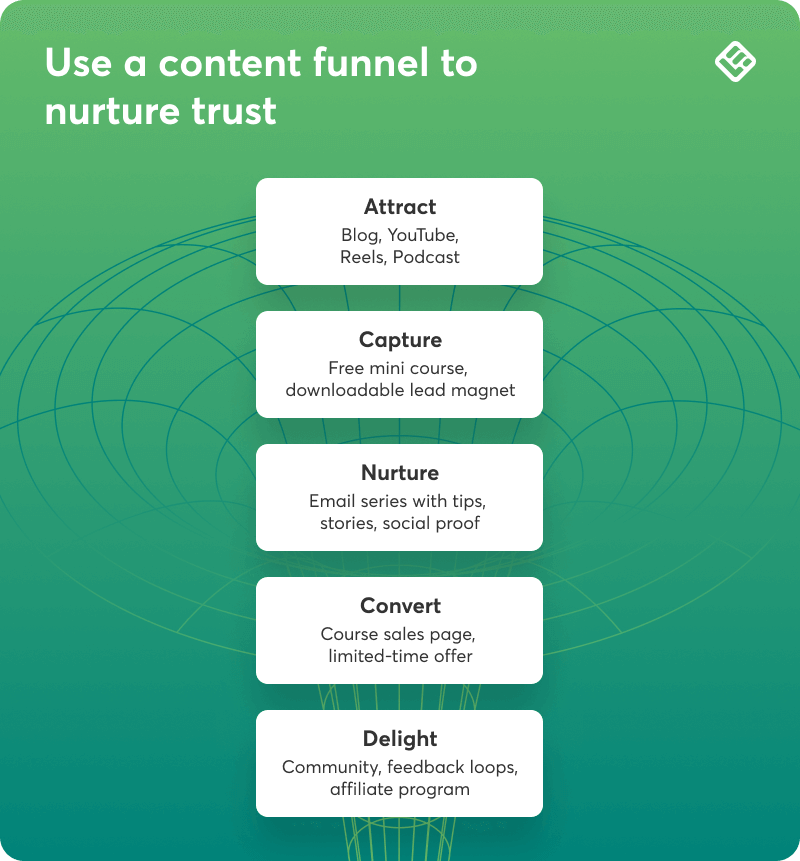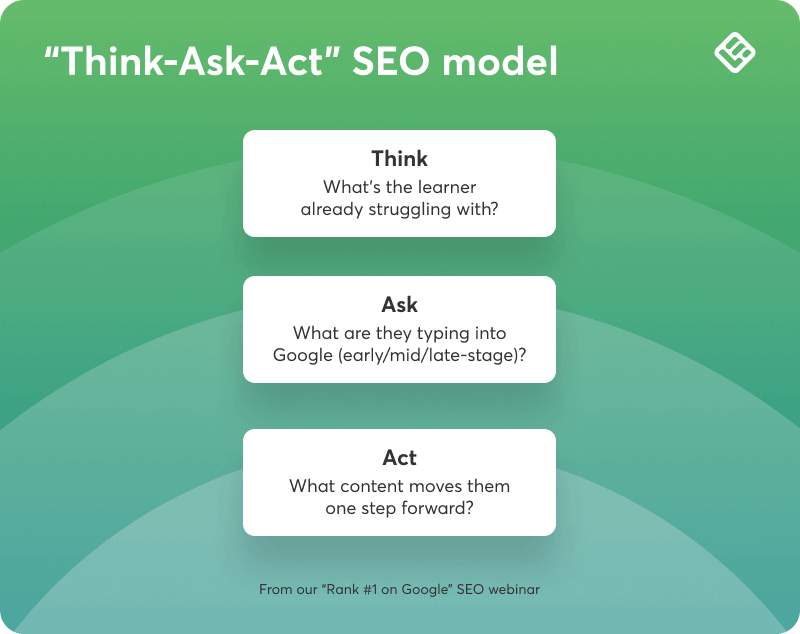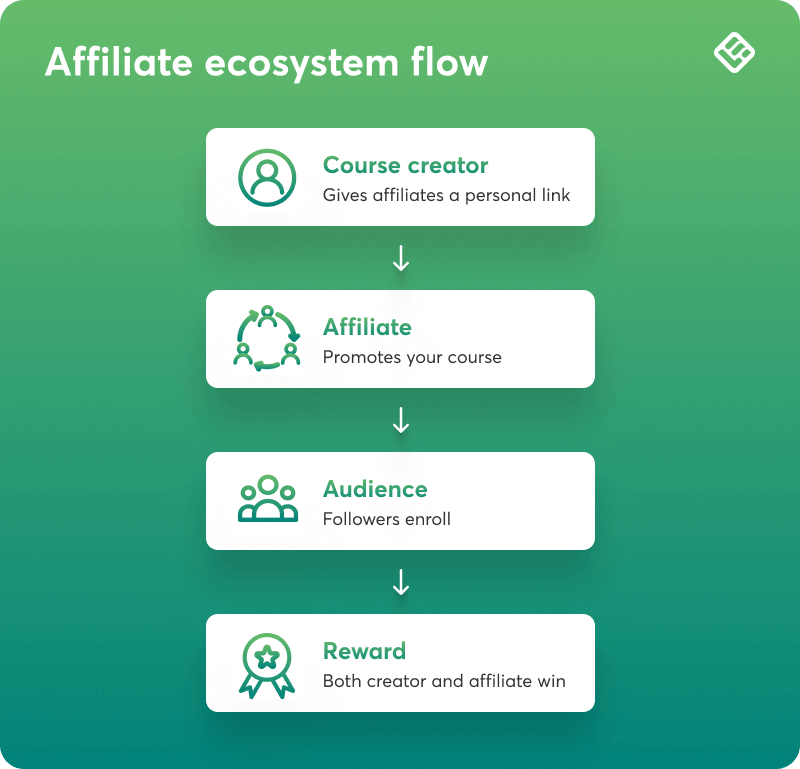Table of Contents
Let’s be real for a second. Creating an online course is a huge milestone. It means you’ve packaged your expertise, passion, and hours (weeks… months…) of hard work into something valuable that can genuinely help people.
But here’s the hard truth: the internet doesn’t owe your course any attention. Just putting your course online doesn’t mean people will find it or sign up.
And that’s where a course marketing strategy comes in—not as a necessary evil, but as the glue that connects your own course to the people who need it most.
If you’re like many course creators I’ve spoken with, marketing might feel like the part you dread the most. You want to teach, not hustle. You want to inspire learners, not play the algorithm game. And you certainly don’t want to come across as pushy or salesy.
You don’t need a massive budget, a giant email list, or a marketing degree to get this right. What you do need to market an online course is a clear, honest, and human-centered strategy that reflects your values and resonates with your people.
In this blog post, I’ll walk you through exactly how to market your online course in 2025 to attract students—step by step, and with all the authenticity, creativity, and ethical marketing practices we stand for at LearnWorlds.
Whether you’re launching a new online course or trying to boost enrollments for an existing one, I’ll cover:
So, if you’re ready to turn your course into a valuable revenue stream, generate leads, grow your online course business, and finally see the results your hard work deserves, keep reading.
This isn’t just another how-to-promote-your-course blog post. This is your marketing blueprint—for humans, by humans.
Preparing to launch your online course
Before you think about Facebook ads, email funnels, or your course sales page, pause and ask yourself one question:
Who exactly am I building this for?
Marketing a course doesn’t start with promotion—it starts with clarity. The more specific you are about your course’s purpose, audience, and value, the easier it becomes to market it in a way that feels natural and effective.
Get crystal clear on your ideal student
Every successful online course starts with a clear picture of who it’s designed to serve. Your course isn’t for everyone, and that’s a good thing. You want to speak to a specific person with a specific need.
Build a student profile by asking:
You can use surveys, informal interviews, or even polls on Instagram or LinkedIn to gather insights. Your goal here is to truly understand their pain points, goals, and language—so your future marketing campaigns will feel like a conversation, not a pitch.
Define your unique value proposition
Now that you know who your audience is, it’s time to clarify why they should choose your course over others.
What makes your course different? It could be your:
This is your unique value proposition. It should come through in every marketing asset you create—from your landing page headline to your social media posts.
Tip: Avoid general promises like “learn at your own pace” or “get expert insights.” Instead, focus on specific transformation. What will your students be able to do, feel, or achieve after taking your course?
Validate your course topic
Even if you’re excited about your course idea, your audience might not be. That’s why validating your course topic early on is essential. Otherwise, you could pour energy into something no one is actually looking for.
Here are three simple ways to validate demand:
If people show interest, ask questions, or even say “when is it launching?”—you’re on the right track.
Set a clear outcome
What do you want your students to walk away with?
A mistake I see often is creators trying to include everything in one course. But great courses are outcome-driven. They don’t teach everything—they teach something that leads to a meaningful result.
Write your course goal in one sentence: “By the end of this course, you will be able to…” Make sure this outcome is visible on your course landing page, sales emails, and in your marketing efforts.
Plan your course creation process
With your audience, topic, and outcome nailed down, it’s time to structure your content and set realistic production goals.
At this stage, consider:
Remember, perfection can wait. Aim for progress, not polish. A clear, well-structured course that solves a real problem will always outperform a “perfect” one that’s sitting in your drafts.
Content marketing strategies to promote your online course
Content is what builds bridges between you and your future students—long before they hit the buy button.
As a course creator, you’re already a content creator. You know how to explain things, teach, and guide. Now it’s time to repurpose that strength into a marketing strategy that draws people in, earns their trust, and warms them up for your offer.
Here’s how to turn content into your best-performing marketing channel.
Start with signature content
Think of signature content as your flagship pieces—the ones that showcase your voice, style, and expertise. These could be in-depth blog posts, podcast episodes, YouTube videos, or downloadable guides.
Choose topics that solve urgent problems for your target audience. For example, if your course teaches personal branding, your signature content could be titled “how to stand out online without feeling fake.” Make it honest, useful, and filled with real examples.
These pieces are perfect for organic SEO and act as lead magnets when paired with a free resource or a free mini course.
Break it down into micro-content
You don’t have to create something new every day. One of the smartest strategies from the ebook is to slice your long-form content into smaller, platform-friendly pieces.
From one blog post, you can create:
This way, your content shows up across social media platforms without you constantly reinventing the wheel.
And it doesn’t always have to be elaborate. Shaun Bettman, CEO of Eden Emerald Mortgages, shared how one of his clients used a short, 3-minute video to deliver a real case study—clear, actionable, and without the fluff:
“I’ve helped plenty of clients who do, and one strategy that’s worked again and again is using short, specific video walkthroughs as lead-ins. One client in the finance space used a simple 3-minute video to break down a real case study. It wasn’t flashy, just clear, direct, and value-packed. At the end, there was a soft call to action to dive deeper in the full course.
What made it work was trust. People felt like they got something real up front, not just a teaser or a pitch. That quick win built credibility, and by the time they hit the sign-up page, they already saw the course as a solution, not a gamble.”
Use a content funnel to nurture trust
Think of content as a journey. Someone sees your short video on social media → reads your blog → signs up for your free mini course → receives nurturing emails → and eventually lands on your course sales page.
Here’s a simple funnel structure to promote online courses:
This turns content into a living, breathing sales funnel—and it works even while you sleep.

Feature real people, not just ideas
User-generated content and student stories are some of the most compelling forms of content marketing. Share:
You’re not just selling a course—you’re showcasing outcomes.
Write for search engines (but keep it human)
If you’re blogging or creating YouTube videos, take advantage of what people are already searching for. Use keyword tools to identify phrases like “how to create an online course,” “best online course platform,” or “how to market your online course.”
But don’t forget—algorithms might bring people in, but personality makes them stay.
Write like you speak. Teach like you’re mentoring a real person. Show that you get them and that your course is built for people just like them.

In our latest SEO webinar for course creators “Rank #1 on Google & sell more courses: proven SEO strategies for 2025”, we explored how to go beyond keyword stuffing and actually create content that ranks and converts. We showed examples of high-converting blog posts, content funnels that bring in long-tail traffic, and how to map topics to different stages of your sales funnel.
If this sounds like what you need right now, you can watch the full webinar on-demand for free and learn how to build a content engine that drives sign-ups—not just pageviews.
Real-world insight: why early-stage content builds long-term trust
Clark Mackey, owner of Cake, shared his “anticipatory SEO” strategy for marketing online courses:
“During economic downturns, when we saw competitors slashing budgets, we doubled down on creating evergreen content that answered questions prospects would ask 6-12 months before they were ready to purchase. Rather than typical “buy now” messaging, we created content specifically addressing pain points that occur early in the customer journey.
For a medical aesthetics client, instead of pushing their training course directly, we built comprehensive resources about “how to evaluate career transitions into aesthetics” that ranked for early-stage search queries.
This approach worked because it positioned our clients as trusted advisors long before the purchase decision. The analytics showed visitors consumed 3-4 pieces of content over several months before converting. Conversion rates for these nurtured leads were 31% higher than paid traffic.”
Clark also emphasized the power of storytelling in content:
“The key is using strong analogies that make complex topics accessible. In one course launch, we compared the learning process to “reaching into a giant mixing bowl and scooping out dough” – giving potential students a concrete mental image they could relate to. When you help people visualize complex processes in familiar terms, they’re much more likely to trust you as the teacher they need.”
Want to master this strategy step by step?
Download the ebook The Content Marketing Playbook for Online Course Creators and get the full content marketing blueprint—including templates, audience-building tips, and a content calendar to plan your next 30 days of visibility.
Social media and community building
When you think about promoting your course on social media, your first instinct might be to post a link and hope for the best. But here’s the truth: links don’t build communities. Conversations do.
Social media is not just a promotion channel—it’s a trust-building ecosystem. And if you approach it with the goal of serving before selling, you’ll build something far more powerful than a following: a course audience that actually wants to learn from you.
Show up where your people already are
You don’t need to be everywhere. You just need to be where your future students are already spending time.
Ask yourself:
Choose 1–2 platforms that feel aligned with both your audience and your teaching style. Then go deep instead of wide.
Provide value before you promote
If the only thing people ever see from you is “enroll now,” they’ll tune out. But if you become someone who regularly shares helpful, insightful, or even entertaining content related to your course topic, they’ll listen when you do promote.
You could post:
Show them that you’re not just selling something—you’re building something useful.
Use community as a marketing asset
Facebook groups, Discord servers, Slack channels—these are not just spaces to promote in. They’re spaces to listen, connect, and co-create with your audience.
You can either:
Inside these groups, avoid cold selling. Instead, be generous. Answer questions. Share free resources. Drop occasional sneak peeks of your online course. The right people will lean in.
Create content that invites engagement
The algorithm rewards interaction, but real relationships come from curiosity.
Try content formats like:
The more human your content feels, the more it resonates.
Use hashtags and mentions wisely
Hashtags still work, but they should be intentional. Use a mix of niche, specific hashtags (#marketingonlinecourses, #coursecreatorjourney) and broader ones (#onlinelearning, #digitalproducts). And tag partners, collaborators, or featured students when relevant—it expands your reach without paid ads.
Repurpose community content
Pay attention to what your audience is already saying. Turn great comments, DMs, or questions into content. Highlight community members, reshare their wins, or interview them for short videos.
This creates a sense of belonging—and shows potential students what it’s like to be part of your course ecosystem.
When you treat social media as a space to serve—not just a space to sell—you build something more sustainable than followers. You build loyalty.
Paid advertising and influencer marketing
At some point in your course promotion journey, you may feel like you’ve “done all the organic things.” You’ve posted. You’ve engaged. You’ve emailed. And now you’re wondering: should I invest in paid ads to get more sign ups?
The short answer is: maybe. But let’s make sure you do it smartly.
Paid ads are not a magic bullet—but when done right, they can amplify your reach, fast-track growth, and connect you with new audiences who are already searching for what you offer.
Start with a tested message
Before you pour money into paid advertising, make sure your course message actually resonates. Ask yourself:
Paid ads work best when paired with a proven offer. Otherwise, you’re just putting fuel on a weak fire.
Use facebook and instagram ads for awareness
Meta ads (facebook + instagram) are great for top-of-funnel visibility. With detailed targeting options, you can reach people based on interests, job titles, behavior, and more.
Ad types to experiment with:
Pro tip: don’t send cold traffic directly to your full course. Instead, guide them to a softer entry point—a lead magnet, a landing page with free access, or a webinar registration.
Test google ads for high-intent traffic
Google search ads work differently. People using Google are already actively looking for a solution. That means your ad can show up right when they type something like:
The key here is to align your ad copy with what people are actually searching for, and direct them to a landing page that delivers on the promise.
Set a small daily budget and test different keyword combinations. Track which ones drive clicks, and more importantly—conversions.
Use retargeting to stay top of mind
Most people don’t buy the first time they see your course. That’s normal. That’s why retargeting exists.
With a small retargeting budget, you can show ads to:
These people already know you. The goal here is to gently remind them, re-invite them, and re-engage them. A compelling course landing page paired with a time-sensitive offer (like early bird discounts) works well here.
For one course campaign, Rob Gundermann, Owner of Premier Marketing Group, shared how a simple incentive helped recover lost conversions for a financial advisor’s course:
“The most underrated tactic was implementing a simple but effective retargeting campaign using remarketing ads combined with time-sensitive incentives. For a financial advisor’s tax planning course, we showed ads to website visitors who viewed the sales page but didn’t purchase, offering a complementary 30-minute consultation as a bonus. This recovered nearly 18% of abandoned carts and boosted overall enrollment by 22%.”
Partner with influencers in your niche
You don’t need celebrity endorsements. What you need are micro-influencers—creators or community leaders who already have the trust of your target audience.
How to get started:
This strategy often works better than paid ads because it’s rooted in trust and recommendation, not interruption.
Set a clear ad strategy before spending
Always define:
And most importantly—track everything. Use pixels, UTM tags, and dashboards to know what’s working.
Partnerships, collaborations, and smart promotions
When you’re a solo course creator or a small team, your reach can feel… limited. There are only so many hours in the day to post, write emails, or run ads. That’s where affiliate marketing and creative collaborations come in.
These strategies allow other people to market your online course for you—and get rewarded for it.
If done with the right partners and the right structure, affiliate marketing can become a powerful and sustainable revenue stream for your course business.
Launch an affiliate program
An affiliate program gives creators, influencers, past students, or industry peers a unique link to promote your course. When someone enrolls through their link, they earn a commission. It’s win-win.
Here’s how to get started:
Affiliates aren’t just marketers—they’re advocates. So choose quality over quantity.

List your course in marketplaces (or get ready to)
Marketplaces are another powerful way to expand your reach and attract new students—especially those who are actively searching for educational content.
While it’s important not to rely solely on marketplaces for all your traffic, being visible in trusted learning directories or platforms can increase exposure, improve SEO, and validate your course with a wider audience.
And yes—we’re working on something exciting at LearnWorlds to help you with this soon. Stay tuned.
Empower your students to refer others
Your existing students are often your best promoters. They’ve already experienced the value of your course content. Encourage them to share it.
Ideas to make it easy:
The key is to make them feel like partners, not just promoters.
Collaborate with complementary creators
Not every collaboration needs to be official. Sometimes a single shared post, co-hosted live, or blog mention can spark new sign ups.
Look for creators who:
Reach out with a simple proposal: “I love your content on [topic]. I think our audiences might overlap. Want to explore a way to support each other’s work?”
It could turn into a podcast swap, a bundle, a joint webinar, or a shared lead magnet.
Run creative campaigns that get people talking
Sometimes, stepping outside the usual promotion playbook is what gets attention.
Here are a few fun ideas:
What matters isn’t being everywhere—it’s being memorable in the right places.
Highlight your partners
Whether they’re affiliates, students, or collaborators—make your promoters feel seen. Mention them in your newsletters. Share their posts. Celebrate their wins.
The more love you give, the more they’ll want to keep promoting your course organically.
Want expert guidance to build and market your course faster?
Join the LearnWorlds Course Accelerator — a hands-on program designed to help you create, refine, and launch your online course with confidence.
Accelerator Wave 4 is now live → Reserve your spot
Direct engagement through email marketing, webinars, and more
If content builds curiosity, and social media builds visibility, then direct engagement is what builds conversion. At some point in the customer journey, people need to hear from you. Not your social media posts. Not your ads. You.
This is where email marketing, live webinars, and interactive formats come in—not just to sell, but to show up and guide potential students toward taking action.
Start with a lead magnet that aligns with your course
Lead magnets are the front door to your course marketing funnel. The best ones give people a small win that hints at the transformation your full course provides.
Try these ideas:
Once they opt in, they’re no longer a passive website visitor—they’re a lead. Now you can nurture the relationship through email.
Set up a welcome email sequence
Don’t just send one email and disappear. Set up a welcome series that introduces who you are, what you teach, and how your course can help.
A good 5-email sequence might look like this:
Use email to move from “nice content” to “I trust this person and want to learn more.”
Build anticipation with a launch sequence
Once your list is warm, a launch sequence turns interest into action. Instead of a one-time announcement, you guide potential students through a journey that builds trust and urgency over time.
Khris Steven, content marketer and automation expert at KhrisDigital, shared how this strategy consistently outperforms generic campaigns:
“For me, it starts with an email list that’s carefully built by offering free resources and mini-courses. Once you have their attention, you need a sequence that nurtures that interest. I send out a series of emails with exclusive insights, actionable tips, and behind-the-scenes looks into the course content. This builds anticipation and shows the value upfront. During one recent launch, this email series resulted in a 40% open rate and a 26% conversion rate, which is much higher than the industry average.”
He adds,
“But what really sets this strategy apart is the authenticity of the message. I focus on telling real stories and addressing actual problems that my audience faces. This has led to more personal connections and, ultimately, higher sales because the course feels like a true solution to their needs.”
Long story short, you don’t need to be flashy. You need to be real—and helpful.
Invite them to a live webinar or info session
Webinars give you the space to connect, teach, and sell—all in one place. And for some creators, they’ve become their most successful lead magnet and sales driver.
Georgi Petrov, CMO and course creator at AIG Marketer, shared, “The most effective marketing strategy I’ve used to sell an online course was leveraging a high-value webinar as a lead magnet. I used the webinar to showcase some of the key lessons from the course while providing real, actionable insights. This approach worked so well because it gave potential students a taste of the value they’d get from the full course. The live interaction created a sense of urgency and allowed me to answer questions in real-time, building trust and credibility. After the webinar, I offered a limited-time discount for attendees, which drove conversions. What made it even more effective was retargeting those who attended but didn’t purchase with follow-up emails, reminding them of the benefits and emphasizing testimonials from previous students. This strategy worked because it created a clear value proposition, built a relationship with the audience, and gave them a reason to take immediate action. It tapped into the power of live engagement, which is often far more compelling than simply pushing a sales page.”
In 30–60 minutes, you can:
Don’t worry about perfection—people value authenticity. A live session, even with hiccups, builds more trust than a polished promo video.
Tip: if you’re nervous about turnout, co-host it with a creator or invite your warmest leads personally.
Send regular broadcast emails
After the funnel, keep showing up. Not just to sell—but to stay top of mind.
Send weekly or biweekly emails that share:
You don’t have to write novels. Short, meaningful emails work well—especially if they sound like a human, not a newsletter template.
Segment your audience for better targeting
Not all leads are at the same stage. Someone who downloaded a free mini course last week might need a little more warming up. Someone who clicked “enroll” but didn’t purchase may need a gentle nudge.
Use tags and email automation to group subscribers by interest or behavior. Then send messages that match where they are.
This makes your marketing feel personal, not pushy.
Direct engagement works because it’s about real connection. When you treat your subscribers and viewers like people—not just numbers—they respond with curiosity, loyalty, and often, action.
Advanced and innovative tactics to stand out
By now, you’ve covered the essentials: content, social media, email, ads, affiliates. But what if your course is in a saturated niche—or you simply want to spark momentum in a more creative way?
These advanced tactics go beyond traditional course promotion. They help you capture attention, build long-term brand equity, and create experiences your future students will actually remember.
Turn your course into a book—or vice versa
If you’ve already developed in-depth course content, consider turning it into a self-published book or guide. You don’t need to be a professional author. You just need a clear transformation and structure.
Your book becomes:
And if you already have a book? Use it to funnel readers into your course with clear CTAs, QR codes, or bonus material accessible only through your course website.
Embed QR codes into real-life touchpoints
If you speak at events, teach in-person workshops, or even create physical products like planners or flashcards, you can use QR codes to bridge offline and online experiences.
For example:
This is especially effective for course creators in wellness, education, art, or professional development spaces where real-world interactions still matter.
Appear on niche podcasts or YouTube channels
You don’t need your own podcast to get in front of audio or video audiences. Being a guest on someone else’s show can give you access to thousands of highly targeted listeners—many of whom are already used to buying from the host.
Reach out to podcast creators who speak to your ideal student and pitch a clear, value-packed topic. Think:
Make sure you end the interview with a soft CTA—like inviting people to download your free mini course or visit your website for more tools.
Create interactive content
Most online course marketing still lives in static formats—text, image, maybe a video. Stand out with interactive elements like:
Interactive content tends to convert better because it involves your audience. They don’t just consume—they participate.
And the best part? These tools can be embedded directly into your course page or used as lead magnets to grow your email list.
Build social proof with more than just testimonials
Testimonials are great. But social proof has evolved. Try showcasing:
It’s one thing to say “this course works.” It’s another to show real people engaging with it in real time.
Frequently asked questions (and the things people are too shy to ask)
Let’s face it—online course marketing comes with a lot of doubts. And most of them aren’t about tools or tech. They’re about confidence, overwhelm, and what actually works.
Below are some of the most common (and honest) questions creators ask—either directly or anonymously in places like Reddit, Facebook groups, or DMs. Let’s clear the air.
How do I market my online course if I don’t have a big audience?
You don’t need thousands of followers. You need the right people, and a way to reach them.
Start with:
Big impact starts small. A small, engaged list is more powerful than a large passive one.
Should I launch my course or keep promoting it all year?
It depends on your energy and business model.
The key is not to rely on one post or one launch to carry your course. Marketing online courses is ongoing.
Should I launch my course or keep promoting it all year?
It depends on your energy and business model.
The key is not to rely on one post or one launch to carry your course. Marketing online courses is ongoing.
How do I market without sounding salesy?
Focus on stories, not just selling. Show the transformation your course creates, not just the features. Let your students speak through testimonials, screenshots, and social proof.
Also, shift your mindset: you’re not interrupting people—you’re helping them. If your course is truly valuable, promoting it is an act of service.
What if my course flops?
It might happen. And it doesn’t mean you failed. Often, it’s just a signal that:
Go back to your students, your data, your own journey. Ask questions. Adjust. Try again. Many of the most successful course creators didn’t get it right the first time—but they learned, iterated, and grew.
Is it too late to start selling online courses?
No. The industry is still growing, but students are getting smarter. They don’t want fluff. They want transformation.
That’s why your unique voice, teaching style, and story still matter. No one can teach the way you do. That’s your edge.
And the best online course platforms (like LearnWorlds) make it easier than ever to build, promote, and grow a course business—without getting buried in tech.
Marketing your course with heart, strategy, and confidence
Marketing your online course isn’t about being everywhere. It’s about showing up—consistently, clearly, and in a way that feels aligned with who you are and what your course promises.
If you’ve made it this far, you’ve already done what most people won’t: you’ve taken time to learn, reflect, and plan before hitting publish or pouring money into ads.
You’re not just promoting a product. You’re inviting someone into a learning experience. That requires care, intention, and a strategy that respects your audience’s time and trust.
So whether you’re prepping for your first launch or optimizing your fifth, here’s what really matters:
And most importantly, remember: the most successful online course businesses didn’t start with massive followings or perfect launch plans.
They started with a single offer, a clear message, and a commitment to keep showing up.
Ready to take the next step?
If you’re looking for an online course platform that supports everything we’ve talked about—sales funnels, affiliate programs, student communities, built-in analytics, and beautiful course websites—start your 30-day free trial with LearnWorlds.
You’ve already done the hard part. Now let’s help your course reach the people who need it most.
Rosemary is LearnWorlds’ Content Marketing Manager. She has over 2 decades of experience in omnichannel marketing and content writing for the IT and SaaS industry. Her expertise lies in crafting effective content marketing strategies that attract, engage, and nurture customers, enabling LearnWorlds to reach its target audiences with precision.
FAQ
Everything you have ever wondered, but were too afraid to ask...
Free methods include:
These methods take time but often build deeper trust with your audience.
At minimum:
Bonus tools include design apps (like Canva), scheduling tools (like Buffer), and keyword planners (like Ubersuggest).

